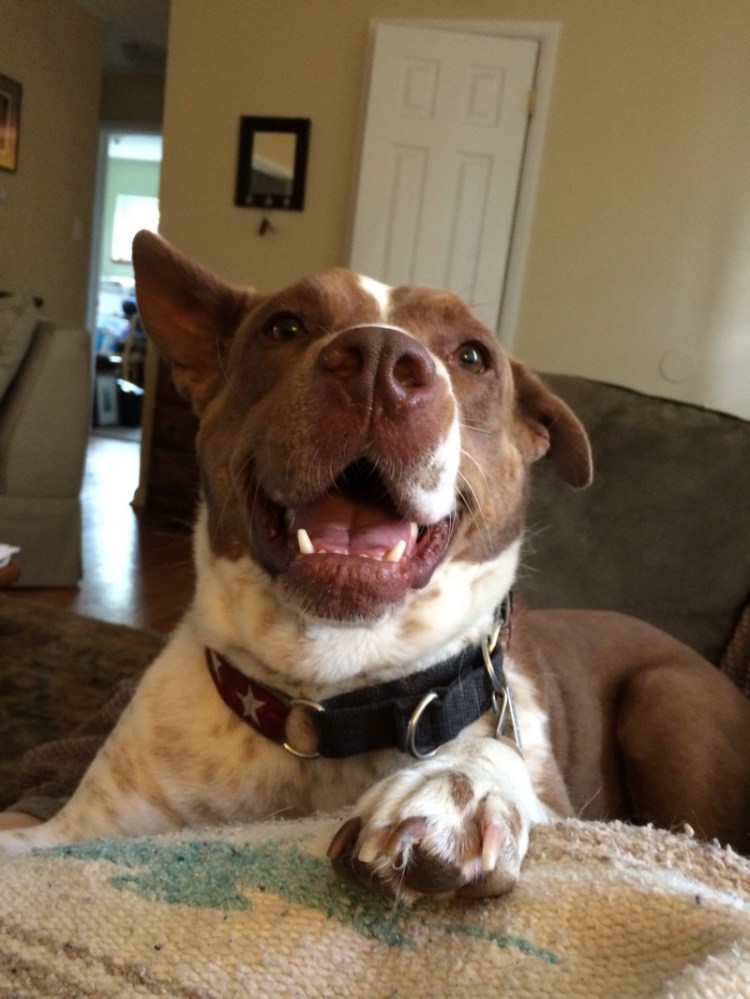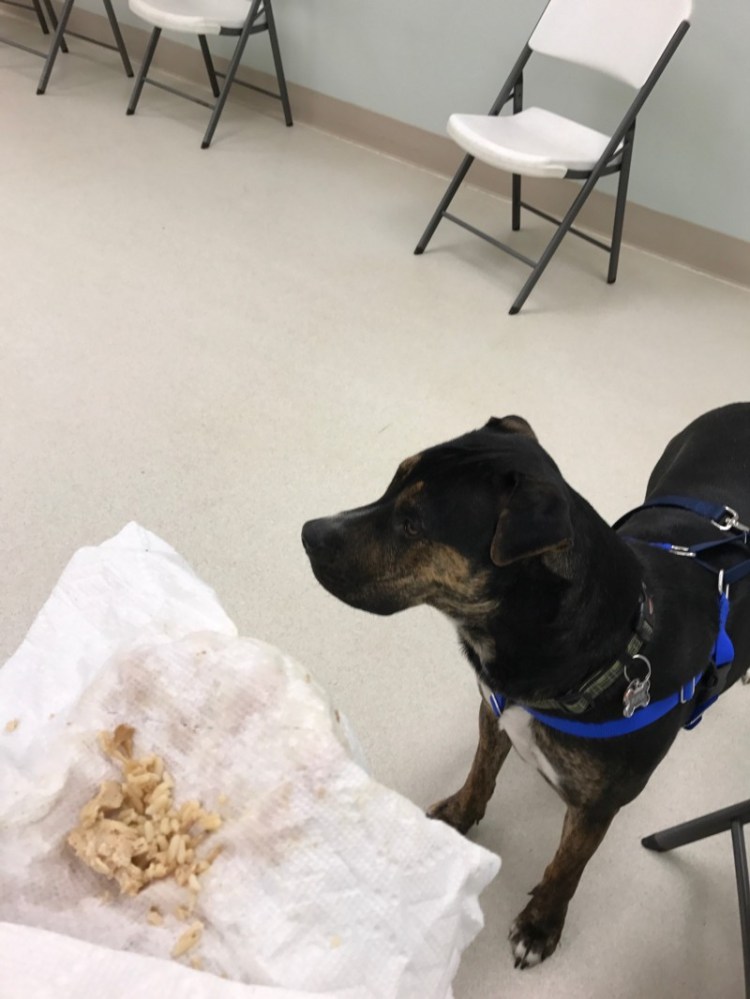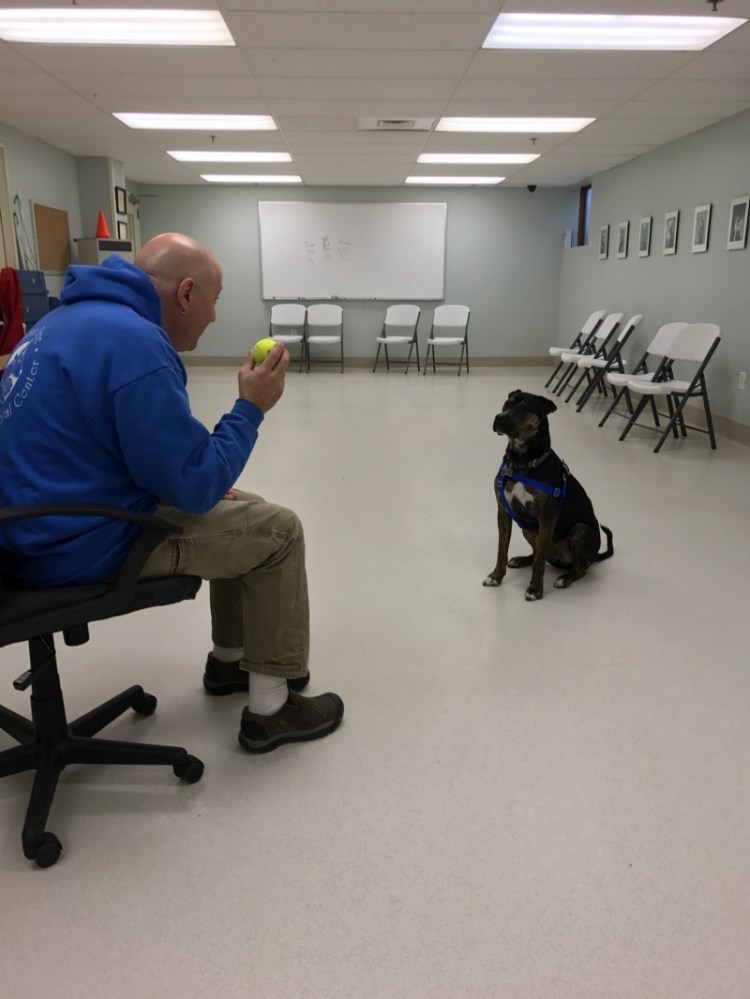Back to basics: For anyone new to the blog – this is what we are all about
Rufus is my second rescue dog. The first is Sophie, and she has been easy-peasy. She came from a shelter where she had been taken care of very well, and before that, while I can never know for certain, I believe she lived in a house and loved people. She barks at TV doorbells, having learned what a doorbell is from someplace other than my home. And she greets everybody with a wiggly tail and joyful pit-bull smile. In her world, strangers are just friends she hasn’t met.

Rufus, on the other hand, was a five-month-old puppy when I found him in a Park Hill alley. He wore a tattered collar to which an equally tattered leash was attached. He most likely had been tied to a fence there and abandoned. He had no tags, and once I got him home and then to the vet, learned he had no chip — which was no surprise. Of course this meant he had no people. And the people he had been able to claim at one point were probably nothing to write home about. They couldn’t even bother to take him to a shelter, for crying out loud so dog care did not have a high ranking with them.
He initially proved skittish and I had to carefully chase him down. Once I managed to grab his leash, he warmed up to me pretty quickly because 1) I gave him food 2) I am female and 3) I could scoop him up easily when he was only five months old. And damn if he wasn’t adorable.

Other people did not have much luck. He gave the vet, the vet techs, and anyone else who came too close a good barking. On walks at our local parks people I knew who wanted to pet him got chewed out, Rufus-style. Sometimes strange places scared him, then other times it was strangers coming into the house that caused him to bark. This dog was a handful. And he was growing like a weed. The thirty pounds of adorability became forty pounds of stubbornness, then fifty. And he wasn’t done growing. I woke up some mornings thinking he was bigger than he had been eight hours earlier. He would start scaring people with his bark — who knows what else he might do? This dog had to be managed.
We tried going to obedience school. We got kicked out. Rufus barked too much because everything made him nervous. I might add that it became clear that they wanted well-behaved dogs at this particular obedience school. It made me think of elementary schools that will only accept high-performing students so that the school’s test score numbers make it look as though they are working so hard when in reality they are taking the easiest students to teach. That was absolutely going on at this place. (I am a former school teacher and can attest that yes, these places exist.)
We needed serious intervention help. Our options were:
- I could hire a training specialist where I drop him off and two weeks later get a trained dog. This would not work because not only are these places extremely pricey, I wanted to be a part of the process. And I wanted positive methods to be used. Many of these places are about dominance and shock collars which I do not think would deal with Rufus’ issues.
- I could use an e-collar on him myself to stop. This would not work on an anxious dog. People do it but I believe it makes things worse. I have seen that happen. Training experts have backed me up here.
- I could give him away. This was not going to happen. I had bonded with this dog. And in any case, what were his chances of survival in a shelter? He is a mostly black-faced dog who barked at strangers. He would not be picked up by anyone. This dog trusted me. This was my responsibility.
- I could go to a behaviorist. This would not be cheap but it was less expensive than the training/boarding facilities, and I could be part of the training process.
Opting for number four, Rufus and I made the forty-five minute trek to a behaviorist. While I had been right about the cost, the experience put my mind at ease. The behaviorist assured that I did not have an aggressive dog; I had a frightened dog. His deep bark makes him appear aggressive but it’s entirely reactive. He does not bite or snap. He doesn’t even bare his teeth. But Holy Hell, this dog has a Barry White depth to his bark so he sounds like he could be a bouncer at a Las Vegas boxing match.
At our sessions, Rufus responded very well to food. Eric, the behaviorist said a truly, deeply scared-shitless dog would not eat. We were not working with the most freaked out dog ever, so that was something. Upon hearing this, I wanted to cry. The recent months had been growing so incredibly stressful that I had become resigned to feeling like a failure.
Eric reassured me that I had correct instincts and that my timing with Rufus was generally on point. However, I pulled at the leash too much and reacted too much to the barking. I could not let the dog train me.

Eric also told me that something intense must have happened during his early imprint stage, which is around the first three months, or earlier. This is what caused the fear of people and was not something he could easily shake. Rufus would never become Sophie. But we could develop some strategies to make everyone’s lives a little less stressful.

The primary things I have learned is:
- Strangers can pet him but must offer a treat and they can’t make direct eye contact. This is non-negotiable or there will be barking. I don’t care if you are a self-proclaimed dog-whisperer.
- He will warm up to women much quicker than men. Guys, don’t take it personally. Seriously. Eric even suggested I tell men that Rufus had a skin disease to prevent strange men from petting him.
- Once is never enough. It takes Rufus a few times to get used new people. If you are a stranger to him and he is finally calm around you, don’t expect the next time to go smoothly. He’ll get there, but it will take time.
- The vet is the scariest place for him. But the people who work there are very nice and are willing to let us have play dates just to help him ease into it.
This is all about patience. I cannot stress that enough. This dog has been training me in the ways of rescues challenges. Just like abused or neglected children, they have often been through the ringer due to no fault of their own. But bad luck does not have to be our fate. I hope that kindness can bring about the reward of acceptance, however wary. It is exhausting but I believe it will be worth it. After all, Sophie adores him.

